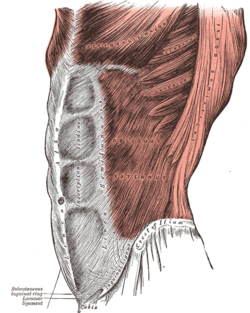This article needs more reliable medical references for verification or relies too heavily on primary sources. (March 2024) |  |
| Linea alba | |
|---|---|
 Diagram of the rectus sheath. | |
 | |
| Details | |
| Identifiers | |
| Latin | linea alba |
| TA98 | A04.5.01.022 |
| TA2 | 2377 |
| FMA | 11336 |
| Anatomical terminology | |
The linea alba (Latin: white line) is a strong fibrous midline structure[1] of the anterior abdominal wall[2] situated between the two recti abdominis muscles (one on either side). The umbilicus (navel) is a defect in the linea alba through which foetal umbilical vessels pass before birth.[1] The linea alba is formed by the union of aponeuroses (of the muscles of the anterior abdominal wall[2]) that collectively make up the rectus sheath. The linea alba attaches to the xiphoid process superiorly, and to the pubic symphysis inferiorly. It is narrow inferiorly where the two recti abdominis muscles are in contact with each other posterior to it, and broadens superior-ward from just inferior to the umbilicus.[1]
The name means white line as it is composed mostly of collagen connective tissue, which has a white appearance.[citation needed]
In sufficiently muscular individuals, its presence can be seen on the skin, forming the depression between the left and right halves of a "six pack".[citation needed]
- ^ a b c Sinnatamby, Chummy (2011). Last's Anatomy (12th ed.). Elsevier Australia. p. 224. ISBN 978-0-7295-3752-0.
- ^ a b Gräβel, David; Prescher, Andreas; Fitzek, Sabine; Keyserlingk, Diedrich Graf v.; Axer, Hubertus (2005-03-01). "Anisotropy of human linea alba: A biomechanical study". Journal of Surgical Research. 124 (1): 118–125. doi:10.1016/j.jss.2004.10.010. ISSN 0022-4804. PMID 15734489.